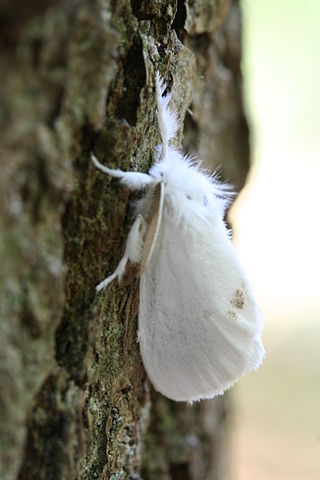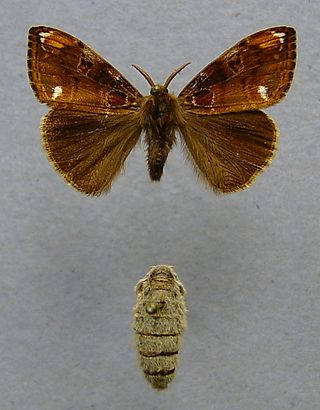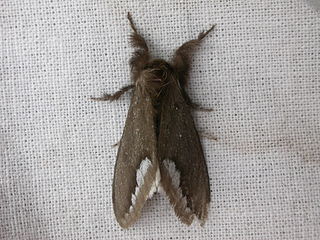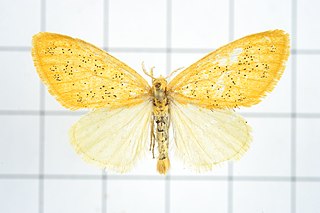
The Lymantriinae are a subfamily of moths of the family Erebidae. The taxon was erected by George Hampson in 1893.

The yellow-tail, goldtail moth or swan moth is a moth of the family Erebidae. The species was first described by Johann Kaspar Füssli in 1775, and has commonly been placed within the related genus Euproctis. It is distributed throughout Europe to the Urals, then east across the Palearctic to Siberia and south to India and Sri Lanka.

Nudaria is a genus of moths in the subfamily Arctiinae erected by Adrian Hardy Haworth in 1809.

Daplasa is a genus of moths in the subfamily Lymantriinae of the family Erebidae erected by Frederic Moore in 1879. It is the sole member of the tribe Daplasini erected Jeremy Daniel Holloway and Houshuai Wang in 2015.

Euproctis is a genus of tussock moths in the family Erebidae described by Jacob Hübner in 1819. Species are cosmopolitan, widespread throughout Palearctic, African, Oriental and Australian regions. Molecular phylogenetic studies indicate that the genus as presently understood comprises a large number of unrelated lineages, only a few of which have names, and is therefore in serious need of revision.

Ivela is a genus of moths in the subfamily Lymantriinae. The genus was erected by Charles Swinhoe in 1903. The type species is I. auripes.
Pellucens is a genus of moths in the subfamily Lymantriinae. The genus was erected by George Thomas Bethune-Baker in 1910.

Pida is a genus of moths in the subfamily Lymantriinae. The genus was erected by Francis Walker in 1865, and including members of the former genus Ramadra.
Ruanda is a genus of moths in the subfamily Lymantriinae. The genus was described by Strand in 1909.

Sphrageidus is a genus of tussock moths in the family Erebidae. It is considered a synonym of the related genus Euproctis by some authors, but still recognized as valid by others (e.g.), and supported as distinct in molecular phylogenetic studies.

Arctornis jonasii is a moth in the family Erebidae, originally placed in its own genus, Topomesoides, which was synonymized with Arctornis in 2015. It was first described by Arthur Gardiner Butler in 1877.

Telochurus recens, the scarce vapourer, is a moth of the subfamily Lymantriinae found in Europe. The species was first described by Jacob Hübner in 1819. The wingspan is 35 to 40 millimetres (1.4–1.6 in) for the males; the females are wingless. The moth flies from June to July depending on the location. The larvae feed on various deciduous trees, such as Crataegus and Salix species. This species has commonly been placed in the genus Orgyia but molecular analyses support its exclusion from that genus, and placement in the genus Telochurus.

The Erebidae are a family of moths in the superfamily Noctuoidea. The family is among the largest families of moths by species count and contains a wide variety of well-known macromoth groups. The family includes the underwings (Catocala); litter moths (Herminiinae); tiger, lichen, and wasp moths (Arctiinae); tussock moths (Lymantriinae), including the arctic woolly bear moth ; piercing moths ; micronoctuoid moths (Micronoctuini); snout moths (Hypeninae); and zales, though many of these common names can also refer to moths outside the Erebidae. Some of the erebid moths are called owlets.

Euproctis limbalis, the bordered browntail moth, is a moth of the subfamily Lymantriinae first described by Gottlieb August Wilhelm Herrich-Schäffer in 1855. It is known from Australia, including Queensland and New South Wales.

Somena scintillans, the yellow tail tussock moth, is a moth in the family Erebidae described by Francis Walker in 1856. It is found in northern India, Sri Lanka, Myanmar and the Andaman Islands. Though considered a minor pest, larva can sporadically be a serious pest.

Euproctis pulverea is a moth of the subfamily Lymantriinae first described by John Henry Leech in 1888. It is found in Japan, Korea and Taiwan.
Artaxa angulata is a moth of the family Erebidae first described by Shōnen Matsumura in 1927. It is found in Taiwan, Myanmar, India, Pakistan, Sri Lanka, Malaysia, Singapore and Indonesia.

Euproctis latifascia is a moth of the family Erebidae first described by Francis Walker in 1855. It is found in India, Sri Lanka and Taiwan.
Kidokuga is a genus of tussock moths in the family Erebidae. The genus was erected by Yasunori Kishida in 2010. It is considered a synonym of the related genus Euproctis by some authors, but recognized as valid by others (e.g.), and supported as distinct in molecular phylogenetic studies.
Kuromondokuga is a genus of tussock moths in the family Erebidae erected by Yasunori Kishida in 2011.















